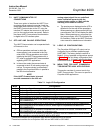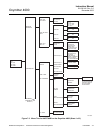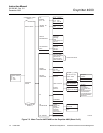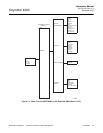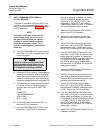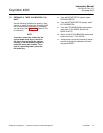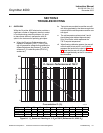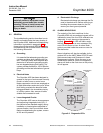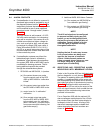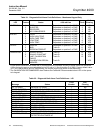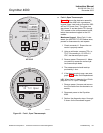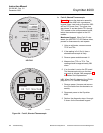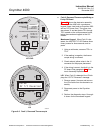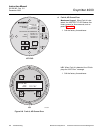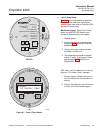
Instruction Manual
IB-106-340 Rev. 3.0
December 2003
8-2 Troubleshooting Rosemount Analytical Inc. A Division of Emerson Process Management
Oxymitter 4000
Install all protective equipment covers
and safety ground leads after trouble-
shooting. Failure to install covers and
ground leads could result in serious
injury or death.
8-2 GENERAL
The troubleshooting section describes how to
identify and isolate faults that may develop in
the Oxymitter 4000. Additional troubleshooting
information is provided in paragraph 8-7 for
those units with the optional SPS 4000. When
troubleshooting the Oxymitter 4000, reference
the following information
a. Grounding
It is essential that adequate grounding pre-
cautions are taken when installing the sys-
tem. Thoroughly check both the probe and
electronics to ensure the grounding quality
has not degraded during fault finding. The
system provides facilities for 100% effective
grounding and the total elimination of ground
loops.
b. Electrical Noise
The Oxymitter 4000 has been designed to
operate in the type of environment normally
found in a boiler room or control room.
Noise suppression circuits are employed on
all field terminations and main inputs. When
fault finding, evaluate the electrical noise
being generated in the immediate circuitry
of a faulty system. Also, ensure all cable
shields are connected to earth.
c. Loose Integrated Circuits
The Oxymitter 4000 uses a microprocessor
and supporting integrated circuits (IC). If
the electronics are handled roughly during
installation or located where subjected to
severe vibration, the ICs could work loose.
Before troubleshooting the system, ensure
all ICs are fully seated.
d. Electrostatic Discharge
Electrostatic discharge can damage the ICs
used in the electronics. Before removing or
handling the processor board or the ICs,
ensure you are at ground potential.
8-3 ALARM INDICATIONS
The majority of the fault conditions for the
Oxymitter 4000 with a membrane keypad will be
indicated by one of the four LEDs referred to as
diagnostic, or unit, alarms on the operator’s
keypad, Figure 8-2. An LED will flash a code
that will correspond to an error message. Only
one LED will blink at a time. An alarm code
guide is provided inside the screw on cover for
the electronics.
Alarm indications will also be available via the
optional LOI or the HART Model 275/375 hand-
held communicator and Rosemount’s Asset
Management software. When the error is cor-
rected and/or power is cycled, the diagnostic
alarms will clear or the next error on the priority
list will appear.
DIAGNOSTIC
ALARMS
TEST
POINTS
HEATER T/C
HEATER
02 CELL
CALIBRATION
CALIBRATION RECOMMENDED
02 CELL mV +
02 CELL mv -
HEATER T/C +
HEATER T/C -
INC INC
DEC DEC
HIGH
GAS
LOW
GAS
CAL
TEST GAS +
PROCESS -
% 02
DIAGNOSTIC
LEDS
37260044
Figure 8-2. Diagnostic LEDs



